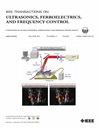A Voltage-Controlled Surface Acoustic Wave Oscillator Based on Lithium Niobate on Sapphire Low-Loss Acoustic Delay Line
IF 3
2区 工程技术
Q1 ACOUSTICS
IEEE transactions on ultrasonics, ferroelectrics, and frequency control
Pub Date : 2024-09-03
DOI:10.1109/TUFFC.2024.3453432
引用次数: 0
Abstract
In this work, we investigate, for the first time, a low phase noise and wide tuning range voltage-controlled surface acoustic wave oscillator (VCSO) based on a lithium niobate on sapphire (LNOS) low-loss acoustic delay line (ADL). The thin-film LN/SiO2 bilayer acoustic waveguide, together with the single-phase unidirectional transducer (SPUDT) design, is key to attaining low insertion loss (IL) by enhancing energy confinement and directionality. Based on a high-performance ADL with an IL of only 5.2 dB, a fractional bandwidth (FBW) of 5.38%, and a group delay of 110 ns, the VCSO is implemented by commercially available circuit components using a series-resonant topology. The LNOS ADL oscillator operates at 888 MHz, showcasing a low phase noise of −94.1 dBc/Hz at 1-kHz offset and a root-mean-square (rms) jitter of only 30.26 fs (integrated from 12 kHz to 20 MHz) while only consuming 16 mA of supply current. Featuring a wide frequency tuning range of 6630 ppm, the proposed VCSO is a promising low-noise, low-power, and high-frequency timing device for emerging applications.Index Terms— Acoustic delay line (ADL), jitter, lithium niobate (LN), oscillator, phase noise, surface acoustic wave (SAW), thin film.skiptabldblfloatfix基于蓝宝石低损耗声延迟线铌酸锂的电压控制表面声波振荡器
在这项工作中,我们首次研究了基于蓝宝石铌酸锂(LNOS)低损耗声延迟线(ADL)的低相位噪声和宽调谐范围电压控制表面声波振荡器(VCSO)。薄膜铌酸锂/二氧化硅双层声学波导以及单相单向换能器(SPUDT)设计是通过增强能量限制和方向性实现低插入损耗(IL)的关键。VCSO 基于 IL 值仅为 5.2 dB、分数带宽 (FBW) 为 5.38% 和群延迟为 110 ns 的高性能 ADL,采用串联谐振拓扑结构,由市场上可买到的电路元件实现。LNOS ADL 振荡器的工作频率为 888 MHz,在 1 kHz 偏移时的相位噪声低至 -94.1 dBc/Hz,均方根抖动(RMS)仅为 30.26 fs(从 12 kHz 集成到 20 MHz),电源电流消耗仅为 16 mA。拟议的 VCSO 具有 6,630 ppm 的宽频率调谐范围,是新兴应用中一款前景广阔的低噪声、低功耗、高频率计时器件。
本文章由计算机程序翻译,如有差异,请以英文原文为准。
求助全文
约1分钟内获得全文
求助全文
来源期刊
CiteScore
7.70
自引率
16.70%
发文量
583
审稿时长
4.5 months
期刊介绍:
IEEE Transactions on Ultrasonics, Ferroelectrics and Frequency Control includes the theory, technology, materials, and applications relating to: (1) the generation, transmission, and detection of ultrasonic waves and related phenomena; (2) medical ultrasound, including hyperthermia, bioeffects, tissue characterization and imaging; (3) ferroelectric, piezoelectric, and piezomagnetic materials, including crystals, polycrystalline solids, films, polymers, and composites; (4) frequency control, timing and time distribution, including crystal oscillators and other means of classical frequency control, and atomic, molecular and laser frequency control standards. Areas of interest range from fundamental studies to the design and/or applications of devices and systems.

 求助内容:
求助内容: 应助结果提醒方式:
应助结果提醒方式:


